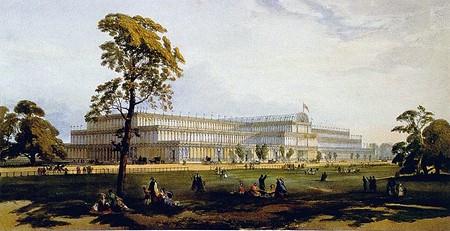|
A housewife at the
One of the most prestigious events in England during the 19th century was the Great Exhibition of 1851 held at the Crystal Palace that had been erected at Hyde Park in London. The event was organised by Prince Albert, consort to Queen Victoria, with the object of displaying the industrial works of all nations and between May and October a total of six million people arrived to see it, equivalent to one third of the entire population of Britain at that time. The exhibits came from Britain and its colonies as well as 44 foreign states in Europe and the Americas and numbered 13,000 in total illustrating development and innovation of the time in all areas of life including a Jacquard loom, an envelope machine, kitchen appliances, steel-making displays and a reaping machine that was sent from the United States. But not everything came from important sources in international business and industry because one section displayed items made by industrious housewives in England who had been busy for months with needle and thread. “The ladies”, proclaimed an introduction to the catalogue of exhibits, “made a very creditable appearance therein and we have proofs of assiduity on their part quite painful to contemplate.” The many items they contributed included a patchwork rug of 30,000 scraps, an item of decorative wool work with 500,000 stitches and an elaborate specimen of knitting containing precisely 1,464,859 stitches and 6,300 yards of cotton. Also among these delightful items was a fancy bed quilt made by Mrs Catherine Fancourt of Grimsthorpe, near Bourne, that received high public acclaim, an item which the catalogue described as “exhibiting an immense amount of labour and great ingenuity” and had been sent to the Great Exhibition on the suggestion of Lady Willoughby d’Eresby of Grimsthorpe Castle where Mrs Fancourt’s husband worked on the estate. It excited great interest among visitors who admired the skill and dedication required in its execution and no doubt the quilt became a family heirloom. Yet the dexterity used in its creation is still evident among our ladies today in the many sewing circles that thrive in the land such as the Knit and Sew Friendship Group at the Abbey Church where ladies of the congregation have also in recent years completed a colourful array of more than 70 kneelers than can be seen among the pews where they are used regularly during services. Members of local organisations also display their handiwork at the many exhibitions held in our towns and villages throughout the year, thus demonstrating that no matter what modern innovations arrive to replace the old ways of doing things, patience, imagination and application still have an important role to play in our everyday lives.
NOTE: Photograph of the Crystal
Palace from the north east from Dickinson's
Go to: Main Index Villages Index |
